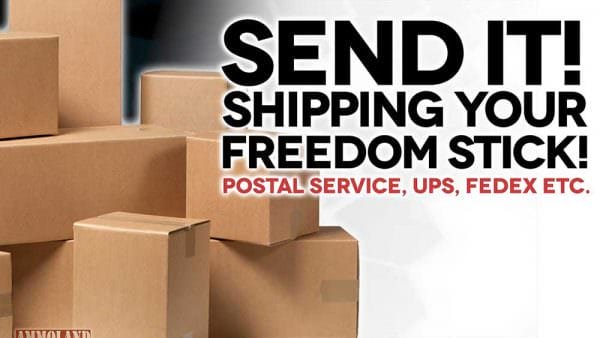
USA – -(Ammoland.com)- Welcome back to The Legal Brief, the show where we CRUSH the various legal myths and misinformation surrounding various areas of the gun world.
I’m your host Adam Kraut and today we are answering the question, can you ship a gun to yourself and talking about the right way to ship a gun. And I swear to God if you use packing peanuts I’m going to vote you off the island.
If you are a NRA life member, an annual member for the past five years, or know someone who is, head on over to adamkraut.com to get a petition to place me on the ballot for the NRA Board of Directors in 2018.
Guns are shipped on a daily basis across the United States by FFLs and unlicensed individuals. If you’ve never shipped a gun before you may be wondering why you would ever need to do that. There are a number of reasons you could ship a gun but the two most likely are that you have either sold the gun or you are sending it to a licensee for gunsmithing. So it’s as simple as boxing it up, heading to your local post office and sending it away right? Not quite.
Depending on the type of firearm, as an unlicensed individual or an individual without an FFL, you may not be able to ship it through the post office at all. Federal law states that “Pistols, revolvers, and other firearms capable of being concealed on the person are nonmailable…” USPS’s Publication 52, which covers Hazardous, Restricted and Perishable mail further states that “short-barreled rifles or shotguns that can be concealed on the person are nonmailable.” Now there are a few exceptions to that which are found in the law and Postal Regulations, which you can find in the notes in the description. The most common being that pistols, revolvers and other firearms capable of being concealed on a person may be sent in the mail to and from manufacturers and dealers. Those with C&R Licenses are able to ship and receive handguns from OTHER C&R licensees IF the firearm is defined as a Curio and Relic under the GCA regulations AND it is an antique firearm. The general exemption for licensees to ship and receive modern handguns does not apply to C&R licenses.
Simply put, you as a non-licensee can ship an unloaded shotgun or rifle, as defined in Publication 52, through the United States Postal Service. The definition tracks closely to what we are familiar with in the Gun Control Act. The firearm has to have an overall length of more than 26 inches and a barrel length greater than 16 inches if a rifle and greater than 18 inches if a shotgun.
A couple things to keep in mind, you may be required by to open the box or complete a written certification to establish that the rifle or shotgun is unloaded and not ineligible for mailing. You’ll also be required to ship the firearm in a manner that provides tracking and signature confirmation, whether it be the class of service you choose or additional service options.
There are two other ways you can ship a firearm, including a handgun. The first would be a common carrier, such as UPS or FedEx. The other would be through an FFL.
If you opt to use a common carrier, you need to head over to their website to review their internal regulations. They vary from carrier to carrier. The common trend is that all handguns will have to be shipped overnight.
There are nuances you want to be aware of, such as things like UPS will not accept machine guns for shipment. If you have a local UPS Store, you may want to call ahead as numerous people have found that they will not ship firearms but rather direct someone to a service hub. FedEx requires that “firearms must be shipped via FedEx Priority Overnight service,” which would make shipping a long gun quite expensive. DHL won’t even ship firearms, so you don’t have to bother looking at them.
Insurance varies from carrier to carrier as well. For instance, for those who are shipping a high value firearm, like a machine gun, through FedEx, may want to look for an alternative way. FedEx will only insure one up to $1,000 and it’s probably a safe bet it is worth quite a bit more. FedEx and UPS shipping regulations are found in the description below. Regardless of whether you choose to use the US Postal Service or a common carrier, the outside of the box must not contain markings that the package contains a firearm.

Lastly, you can opt to use an FFL who offers the service, to ship your firearm to its destination. Some FFLs require that shipments to them come from another FFL. This is not law or regulation but merely their own policy. If you are shipping something to an FFL, you’ll want to include a legible copy of your driver’s license, or other form of valid government issued photo ID, so that they are able to log the firearm into their A&D Book. If you are shipping through an FFL, you do not need to provide a copy of your ID in the package, as the FFL will provide a copy of their license to the FFL receiving the shipment.
For those of you that plan on having gunsmith work done on your firearm, if you choose to send it directly to the gunsmith, you can have the firearm returned directly to you. It is also possible to ship a firearm to yourself in another state. However, you are going to be using the postal service to do so since UPS and FedEx’s regulations will not allow a person to ship a firearm to themselves. So if you’re going hunting out of state and don’t wish to fly with a firearm, you can ship it to your destination, but there are a few things you need to be aware of.
USPS says that a rifle or shotgun owned by a non-ffl can be mailed outside of the owner’s state of residence, by the owner, in care of another person in the state where they intend to hunt or engage in a lawful activity. The package must 1) be addressed to you, the owner, 2) include the “in the care of” endorsement immediately before the name of the temporary custodian, 3) be opened by the owner only and 4) be mailed using a class of mail or service that provides tracking and a signature at the time of delivery.
So for instance, if Jon here in PA wanted to go hunting with Eric down in Georgia, he could ship his rifle and shotgun prior to his flight. He would need to address the package to himself, followed by “in the care of” Eric and the address. It would also need to include tracking and signature confirmation. Once Eric signed for and received the package, he would need to hold it until Jon arrived and only Jon could open the package.
As of right now, there is no way to ship a handgun to yourself out of state without violating the law or company policy of UPS or FedEx. And for those of you thinking about shipping a handgun to yourself by sending it to an FFL, think again. Unless you are able to prove residency in the state where that FFL is located, they will be unable to transfer the firearm to you. If you want to bring a handgun out of state, you’re either flying with it, driving, or possibly taking the train.
As you can see, shipping firearms is not quite as simple as heading down to your local post office, but it isn’t a difficult thing to do. If you know someone who has questions about shipping a firearm be sure to send them this video. If you learned something new or found it informative be sure to hit that like button. And if you aren’t subscribed already, you better make that happen and be sure to ring that bell so you don’t miss an episode. Also, check out my website adamkraut.com.
And as always thanks for watching!
Links for this episode:
- 18 U.S.C. § 922(a)(2)(a) and (a)(5)
- 18 U.S.C. § 1715 – Firearms as nonmailable; regulations
- USPS Publication 52 | Definitions and Mailability
- UPS Firearms Regulations
- FedEx Firearms Regulations
- ATF FAQ – May a non-licensee ship firearms interstate for his or her use in hunting or other lawful activity?
- ATF FAQ – May a non-licensee ship a firearm by a common or contract carrier?
- ATF FAQ – May a non-licensee ship a firearm through the U.S. Postal Service?
About The Gun Collective
The Gun Collective is dedicated to bringing you the highest quality, fast-paced gun content possible. Started in June 2015 by Jon Patton, TGC has rapidly taken off to become a go-to source for the things you need to know without a bunch of BS. Please check out TheGunCollective.com to learn more and see what the hype is all about!
